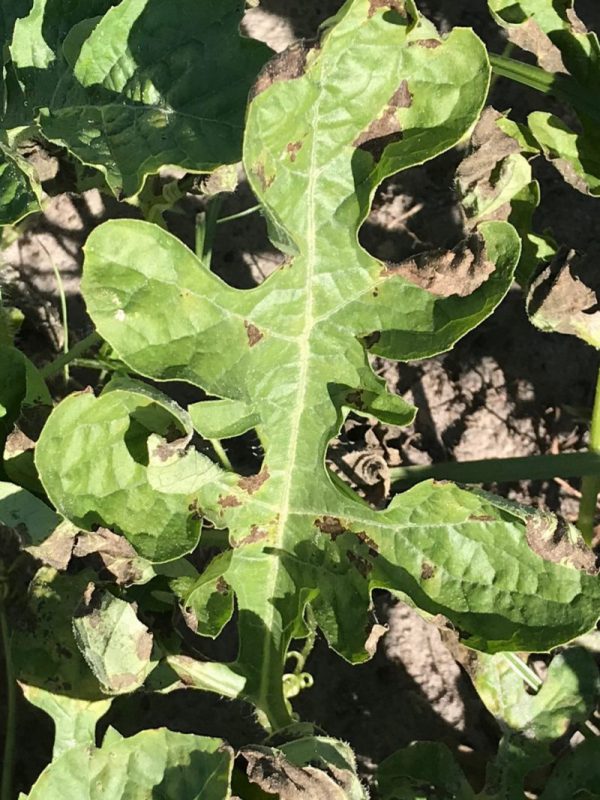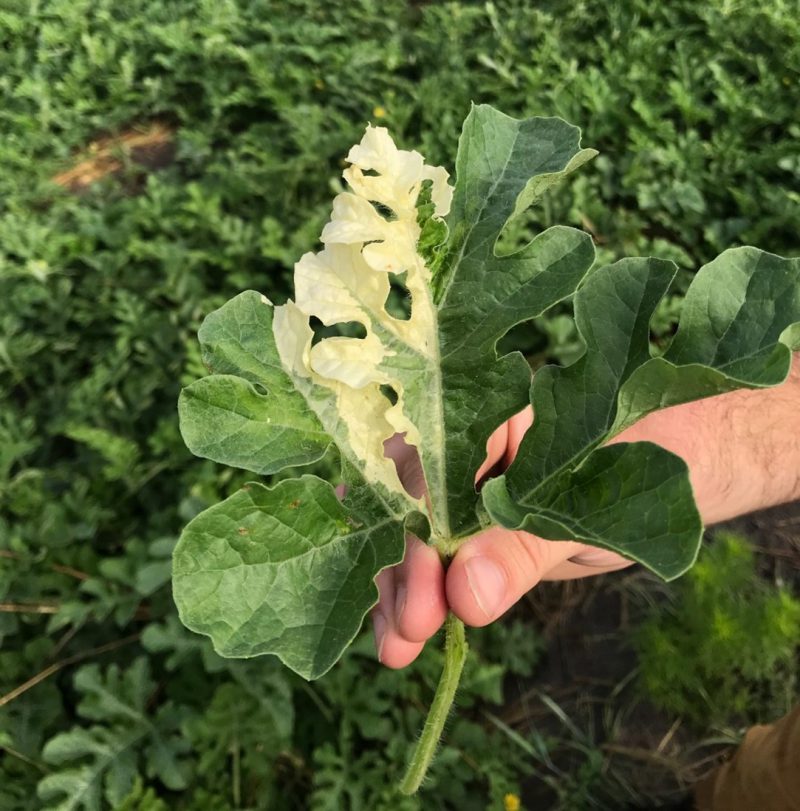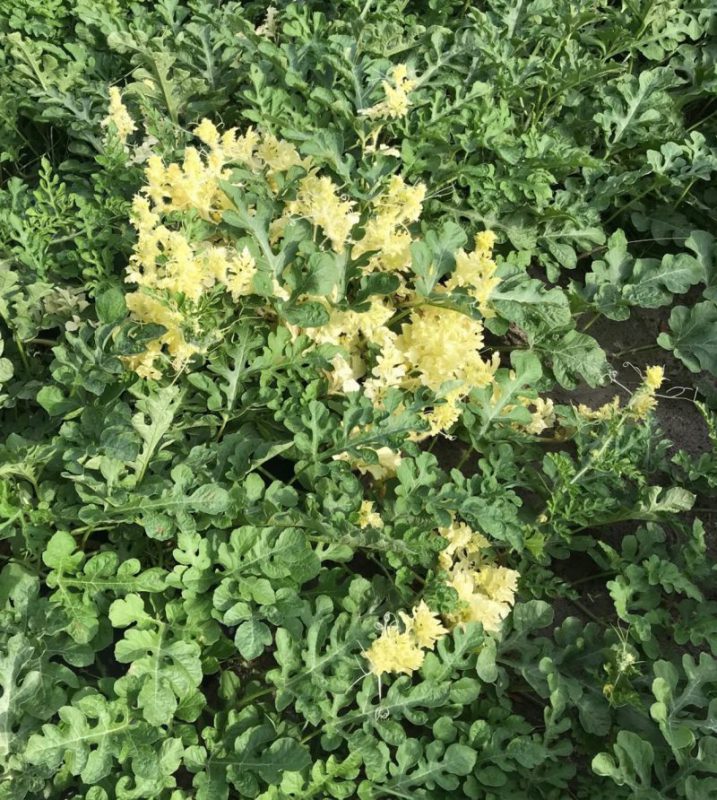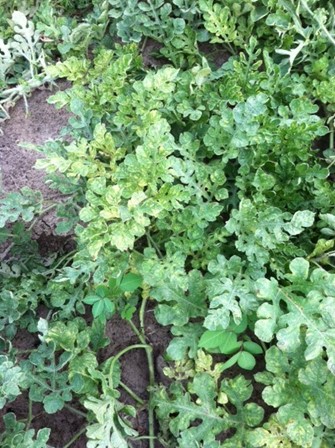Downy Mildew Alert
There have been several reports of downy mildew in watermelon in the southern part of the Suwannee Valley region the past couple days. We will get lab confirmation as soon as possible, but we are confident downy is here. I can also indicate we did have a first confirmed case of downy mildew in a pumpkin variety trial at our Center a few days ago. Downy mildew is the disease traditionally known as “wildfire”. Last year the disease arrived in early May. Because of the high risk of damage and movement throughout the region, we are expressing a high level of concern. Plan to spray, if you have not already initiated a program targeted at downy mildew, especially in the southern parts of the Suwannee Valley region (Levy and Gilchrist Counties are where the reports have been made.) The disease is expected to continue to move north to Suwannee, Lafayette, Columbia, Madison, and Union Counties next. Contact your Extension Agent if you see areas of the field where the plants look blighted (dried up leaves sticking straight up in the mid part of the canopy). The leaves in more advanced stages will quickly become “crispy” with the leaf veins being the only part of the leaf to not become crispy and dry (see photos below). You should consider adding one of these fungicides to your program soon. The best choices, based on recent trials, are Ranman, Orondis Ultra, or Zampro (all three have a zero-day pre-harvest interval (PHI)) and should be added to a broader spectrum mancozeb (Manzate or Penncozeb (5 day PHI)) spray, plus either Quintec or Procure, for the continued pressure from powdery mildew. Good luck with this additional challenge. For those fields where downy has been confirmed, we have suggested starting with Orondis Ultra or Zampro this week, and Ranman next week. Where downy mildew has not yet been detected, you could start with Ranman this week and follow with Orondis Ultra, or Zampro. Be very cautious with your spray this week in the high temperatures. The likelihood of burn is greater when temperatures are high, and 2-3 materials are tank mixed.
–
–
Feature This Week- Chimera
The following photos show a characteristic unusual color pattern in a plant or part of a plant. The unusual color pattern is caused by a genetic mutation and is known as a chimera. It is striking, but not of concern as it is not a pathogen or disease. Chimera is due to a mutation, typically spontaneous rather than induced, resulting in cells of different genotypes (genetic makeup) growing adjacent to one another. A common type of chimera is variegated plants. Some tissue is yellow to white because those cells are unable to synthesize chlorophyll. (Bob Hochmuth)
–
–
Nutrient Management Update
Once we start harvest, it is common to set the rate at 2.0 lbs per acre per day and leave it there until one week from last pick. (Bob Hochmuth)
Insect Update
We have confirmed a couple of isolated cases of spider mite damage this past week. This is not surprising in extended periods of dry weather. Spider mite feeding typically results in patches of yellow-bronze coloration (see photo left) of leaves in distinct spots in the field, often starting in the perimeter of the field. If you see these patches, contact your County Extension Agent for diagnosis.
We continue to receive confirmations of rindworm feeding. As a reminder, the better materials will include the higher labeled rates Intrepid or Coragen (as a spray only) which are also safe to pollinators. Do not use pyrethroids (bifenthrin, Asana, Lambda, etc.) for control of rindworms, as there is a very high level of resistance to that class and they are very toxic to bees. (Bob Hochmuth)
–
Reminder- Join the Florida Watermelon Association
It is the mission of the Florida Watermelon Association to support research, education and promotion of the fresh Florida watermelon industry. If you are not a current member, I encourage you to join. Your voice as a watermelon farmer needs to be heard on so many issues, now more than ever. All watermelon farmers and allied industry representatives should join. I am a member, and I encourage every reader of this weekly update to join as well. To join, go to https://www.flfwa.com/
Thank You to the Suwannee Valley Rapid Diagnostic Watermelon Program and Its Industry Sponsors
UF/IFAS Extension agents have initiated a more formal way to support our watermelon growers with a rapid diagnostics system through Suwannee Valley Regional. This industry-funded program allows Extension Agents to submit and pay for watermelon grower plant disease and other diagnostic samples. This SV Rapid Diagnostic Watermelon Program will help us to get quicker diagnostic results and not have to charge the growers directly. Plant disease samples are typically $40 and leaf tissue analyses are typically $20. We want to thank the initial sponsors of this program: Syngenta Crop Protection, Harrell’s Fertilizer, Koppert Biological Systems, SEEDWAY LLC, BASF Vegetable Seeds, Bayer Crop Science, Gowan Seed, and Gowan USA for sponsoring this effort. Other industry reps interested in sponsoring this effort can contact Bob Hochmuth at bobhoch@ufl.edu or 386-288-6301.
- 2024 Watermelon Season Wrap Up - June 21, 2024
- Weekly Watermelon Update – June 3 - June 7, 2024
- Weekly Watermelon Update #10 – May 20 - May 24, 2024





